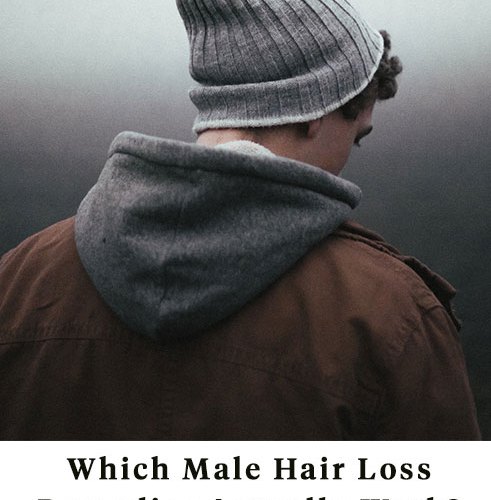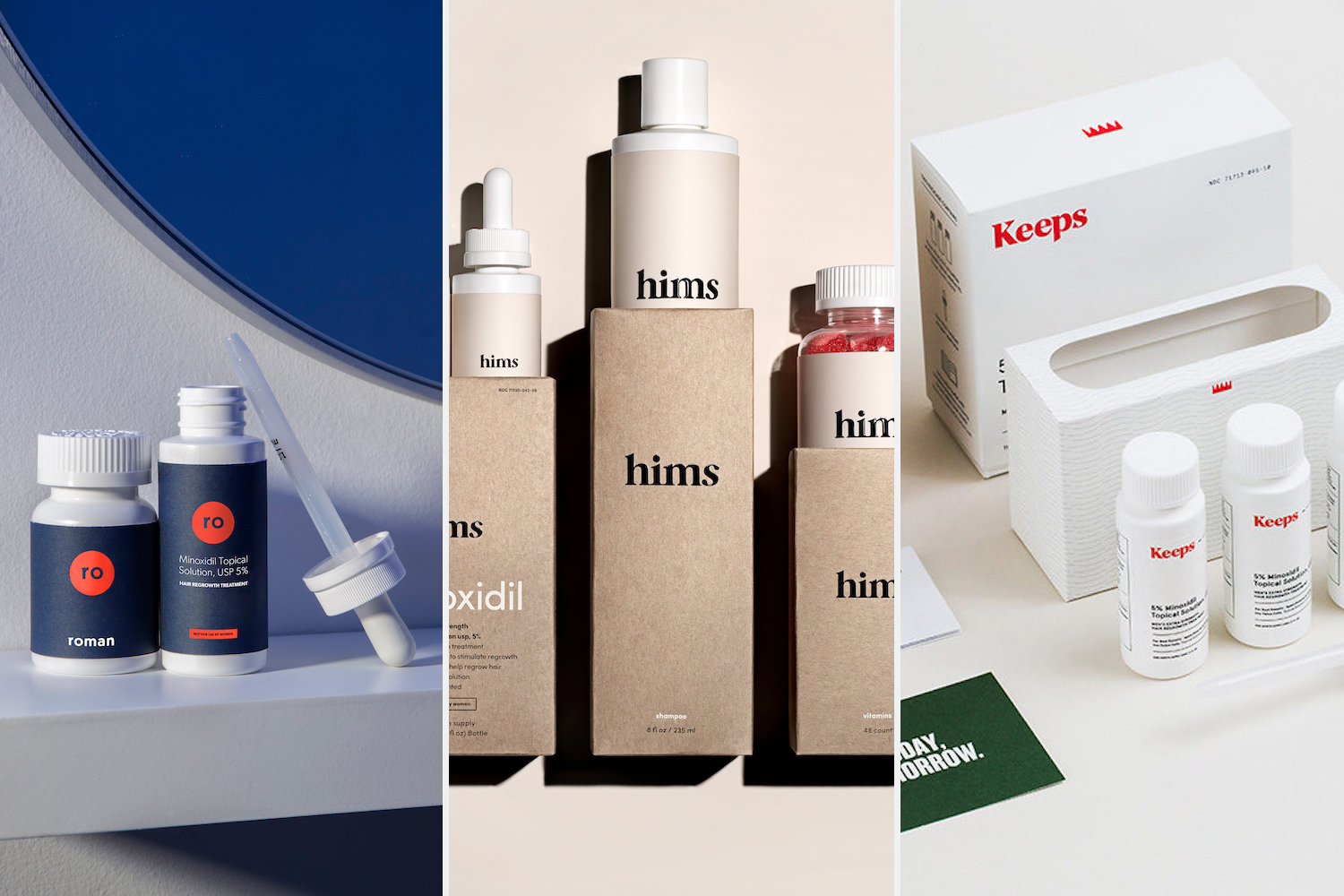
Nota bene: All products in this article are independently selected and vetted by InsideHook editors. If you buy something, we may earn an affiliate commission.
Are you losing your hair? If you’re over 35 and a man, it’s the most likely scenario. But despite male pattern baldness afflicting the majority of men of a certain age, it’s not something anyone wants to talk about.
Thankfully, a number of new companies have launched in the last few years looking to not only destigmatize the issue of hair loss among men, but also help treat it. Telemedicine startups like Hims, Roman, Keeps, Lemonaid and Blink Health all promise to help you keep your hair via solutions you can order easily and discreetly online, whether that be prescription pills, topical drops or even gummy vitamins.
The problem? The history of baldness cures is one populated mostly by snake-oil schemes, whether we’re talking miracle elixirs of yore or late-night infomercials of the ‘90s. And the advent of the internet has only increased the spread of misinformation.
To determine whether or not you should trust these newer companies with solving your tonsorial woes, we got in touch with Dr. Jaime Davis, Board Certified Dermatologist, as well as the Medical Director and CEO of Minnesota’s Uptown Dermatology and SkinSpa. She walked us through our questions about male pattern baldness (what’s the difference between finasteride and Propecia?), the pros and cons of these online services (should you see a doctor instead?) and the most effective hair-loss solution available.
But before we get to that, the first thing to understand is there are two types of hair-loss companies we’re dealing with: specific men’s health providers and general telemedicine providers.
Men’s Health
- Hims: Offers hair-loss solutions as well as treatments for erectile dysfunction, premature ejaculation and skincare.
- Roman: Offers hair-loss solutions, plus sexual-health (more comprehensive than Hims) and general-health services (from heart health to quitting smoking).
- Keeps: As the name suggests, Keeps focuses on hair loss only (for now).
General Telemedicine
- Lemonaid: A self-described online doctor’s office and mail-order pharmacy that delivers prescriptions to your home or a local pharmacy.
- Blink Health: Primarily a service offering lower-cost prescription drugs, but it also provides online doctor visits.
What do these companies offer?
The one solution they all offer is a hair-loss pill called finasteride (in 1mg tablets), the generic version of the brand-name drug Propecia, which you’re probably familiar with. Basically, the medication can stop a hormone called dihydrotestosterone (DHT) from causing hair loss in men. As Dr. Davis told us, roughly 80% of men experience hair regrowth or maintenance with finasteride, so it’s the most effective solution available. But the men’s health services offer additional solutions, too. All three offer minoxidil in topical drops or foam (the generic version of Rogaine), which Dr. Davis put around a 60% effectiveness rate. Hims and Keeps also offer hair-wash products (shampoo and/or conditioner), and Hims goes the extra mile with biotin gummy vitamins.
More than that, all of these services offer some form of online doctor’s visit to prescribe treatment as well as home delivery, and as finasteride is now available in its generic form they also purport to offer cheaper-than-pharmacy prices.
In other words, these services say they’re faster, cheaper and easier than dealing with hair loss at an in-person doctor’s office. But is that the whole story?
What to know before ordering hair meds online
Your hair loss might not be male pattern baldness
The number-one concern Dr. Davis has is the effectiveness of diagnosing male pattern baldness (formally known as androgenic alopecia) in an online setting. All the services pair an online survey (which sometimes includes uploading photos of your hair) with a consultation with a licensed physician. But there are other reasons men may experience hair loss, including thyroid disease, anabolic steroid use and the autoimmune disorder alopecia areata. While the online services are thorough, they can’t provide the same level of care as seeing a dermatologist in person; Dr. Davis cited the simple blood tests he does “to check that there isn’t an excess production of testosterone” as well as checking for “enlarged male breast tissue [which] could be a sign of hormone issues.”
The side effects of finasteride
That misinformation we mentioned earlier? If you Google “Propecia,” one of the first links that comes up is “Why I’d never take the hair loss drug President Trump uses” (because apparently he pops Propecia). The article is undiluted, fearmongering clickbait that has probably steered people away from a hair-loss solution that could work for them. That said, there are very real side effects of finasteride that you need to be aware of, mainly, as Dr. Davis pointed out, impotence. The risk is about 1%, and it’s “generally reversible,” but some people may not be willing to take that risk. All of these services note the potential side effects, but like the dozens of privacy policies people accept for online services, they may not be explained or understood with the proper gravity as when explained by a doctor face-to-face.
You can buy some of these products at your local drug store
Finasteride is the most effective FDA-approved form of hair-loss prevention, but what about the generic Rogaine, various shampoos and biotin gummies? They’re actually all available over the counter, but most of these services won’t divulge that, at least not up front. And while minoxidil is effective, as Dr. Davis notes, ketoconazole shampoo (which is offered by Keeps) is an anti-dandruff solution that is “likely unnecessary in male pattern baldness” and biotin (offered by Hims) “can’t hurt, but is more for generally for thinning of the hair and nails, and is not specific to male pattern hair loss.”
You don’t have to start with a pill
As we’ve already established, finasteride isn’t a miracle pill, but it is the showcase solution for hair loss for each of these services, and with all the hype, men might feel pressured into taking it right off the bat. But there are other options. “I often add finasteride to a Rogaine program if a 6-12 month trial of Rogaine doesn’t work. If the topicals work, why add a pill?” said Dr. Davis. “So I go stepwise unless the patient wants to go right to the pill.”
Be aware of the medical training of your provider
All of these online services offer, at minimum, consultations with “licensed physicians.” But as Dr. Davis points out, that may not mean what you think it means. “Does convenience come with a price? Yes: ambiguity and transparency of provider credentials and experience,” she said. “Physician licensing is the most basic qualification … so being a ‘licensed physician’ isn’t saying much about their training and competency.” In other words, while some may be trained in treating hair loss specifically, others may not. And the caregivers may run the gamut from board-certified doctors to nurse practitioners to physician’s assistants, and even the board-certified doctors may not be certified in dermatology specifically.
The price may (or may not) be cheaper
One of the big claims of these online services is that they offer finasteride for a lower price than you’ll find at your local pharmacy, but is that true? Not including fees for doctor consultations, the lowest prices for one month of finasteride (i.e., 30 1mg tablets), in descending order, are $30 from Lemonaid, $28.50 from Hims, $25 from Keeps, $20 from Roman and $8.33 from Blink Health. But if you look on GoodRx.com, a website that shows you the different prescription drug prices at pharmacies near you, you may be able to find one that offers it for even less. For example, near me, one month ranges from as much as $30 per month to as little as $4.67 at Costco — yes, lower than any of these.
Who should use online hair loss services?
If you already take finasteride, use minoxidil or do both, these services are a great way to get your hair-loss solutions without having to go to an office and a pharmacy, and a great way to potentially find lower prices, especially through Blink Health. If you’re interested in starting a hair-loss treatment program for the first time, Keeps and Roman are clear, streamlined platforms, but they are not without limitations.
“Yes, not everyone needs a Mayo-educated, board-certified dermatologist to tell them they need Rogaine,” said Dr. Davis. “So I am all for convenience as long as the providers are transparent about their qualifications and have enough know-how to know when to refer a patient to a conventional in-office physician.”
In other words, if you want to see a board-certified doctor about your hair loss, don’t trust one of these companies to deliver that. For that, do things the old-fashioned way: book an appointment with your local dermatologist and get a thorough prognosis.
We've put in the work researching, reviewing and rounding up all the shirts, jackets, shoes and accessories you'll need this season, whether it's for yourself or for gifting purposes. Sign up here for weekly style inspo direct to your inbox.
